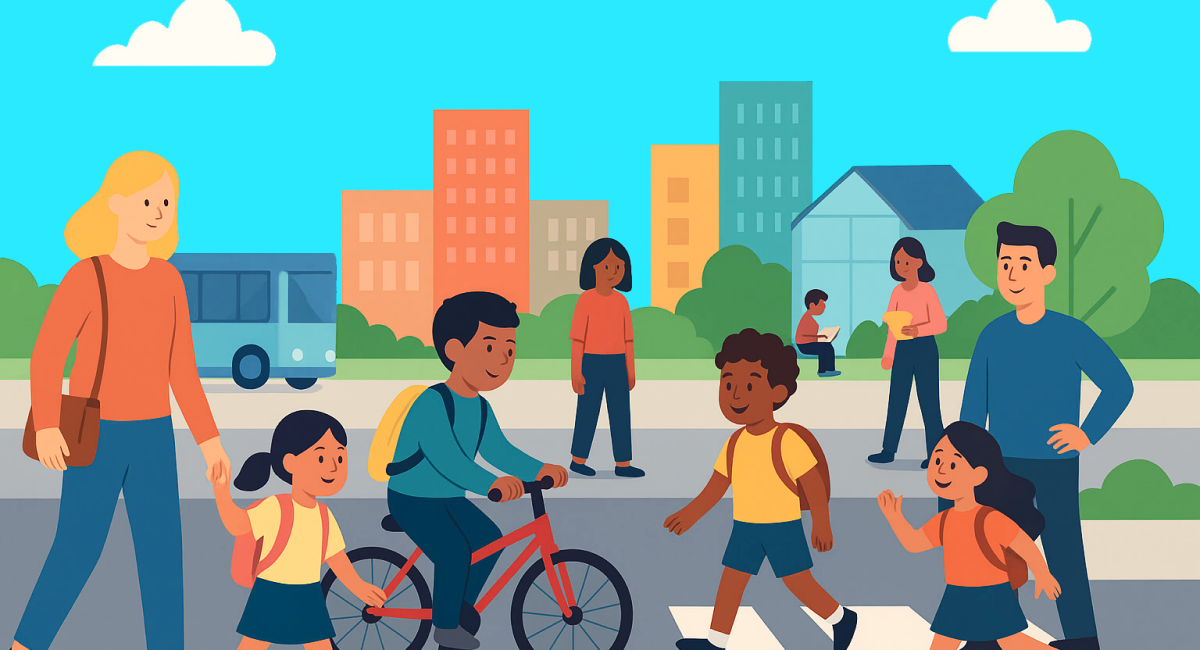Exploring Generative AI and inclusion in the CONIFER project
In a time when Artificial Intelligence seems to be everywhere—from policy debates to playgrounds—the real question is not if we should use AI in our work on urban mobility and public space, but how. Can AI help us reimagine cities with children? Can it support inclusive foresight processes and empower unheard voices?
At CollectiveUP, we’ve been asking these questions as part of our contribution to the CONIFER project—a Horizon Europe initiative funded under the Driving Urban Transitions (DUT Partnership 2023) focused on rethinking mobility futures for school children.
Last week, our internal workshop on AI and Generative AI brought together experts, researchers, designers, and facilitators to dive deep into how AI can (or should) be used across the project. The outcome? A vibrant exchange of possibilities, concerns, and provocations that pushed us to think ethically, inclusively, and creatively about the future.
From neural nets to swarms: What we talked about
Led by AI expert Frederick Ducatelle, the session began with an insightful overview of recent AI advances. We unpacked the mechanics and use cases of:
- Large Language Models (LLMs) like GPT that generate and analyse text
- Retrieval Augmented Generation (RAG) for grounded, accurate outputs
- AI Agents capable of iterating and planning across complex workflows
- Swarm Intelligence, mimicking ants or birds, to support consensus and decision-making
These weren’t abstract theories. We anchored each method in CONIFER’s real-world needs: understanding mobility cultures, engaging children inclusively, designing future scenarios, and analysing diverse, multilingual datasets.
AI for engagement, equity, and evaluation
Throughout the day, we mapped dozens of concrete opportunities for AI to support the project’s vision. Some highlights:
1. Inclusive engagement with children
Could voice-based AI agents invite children to explore their city differently, sparking curiosity and empathy? Could GenAI help kids who prefer visual or digital expression—especially those with neurodivergent profiles or language barriers—participate more equally?
2. Analysing civic voices and narratives
LLMs could help us process open-text survey data, detect biases in policy discourse, or compare children's narratives with political ones. In a time of polarised digital ecosystems, tools that illuminate what’s missing from the conversation are gold.
3. Bias detection and representation
How do we know which voices are loudest, and which are silent? AI could help detect patterns of exclusion—e.g. in gendered mobility experiences or migration narratives—across social media, surveys, and workshops.
4. Foresight, visualisation, and scenario creation
Imagine children designing future cities using Minecraft and AI tools that help build structures or visualise car-free futures. By combining AI with participatory methods like CRISPA, we can co-create more vivid, inclusive, and tangible scenarios for sustainable mobility.
5. Accessibility, simplification, and feedback loops
From translating media across languages to simplifying surveys into B1 reading level for children, AI offers tools to help us communicate with more people, not fewer. It can also check the clarity and consistency of feedback, helping us close the loop with participants.
What are the risks?
The team didn't shy away from difficult questions. Key concerns included:
- Data protection, especially when dealing with children's images or GPS-based mobility data
- Biases baked into AI models, particularly in generative tools that reproduce stereotypical visuals
- Creativity and human agency, with a clear agreement: AI must support, not replace, the human imagination
- Transparency and explainability, particularly when AI is used in public-facing processes
Rather than viewing these as blockers, we saw them as design prompts. We need to design with the risks in mind, applying AI intentionally, and always ensuring human oversight and ethical safeguards.
What’s next for AI in CONIFER?
This workshop marks only the beginning. In the coming months, we’ll be:
- Mapping where AI can add value in the project timeline
- Exploring open-source, lightweight, and privacy-conscious tools
- Collaborating with civic labs and children to test AI’s inclusivity potential
- Iterating on the CRISPA foresight software with AI-based improvements
- Documenting and sharing our methodology for wider use across the EU
As Frederick Ducatelle put it during the workshop:
“The most powerful outcomes come when humans work with AI—not when AI replaces us.”
The bigger picture
For us at CollectiveUP, this workshop wasn’t just about deploying new tech. It was about rethinking what participation means in a digital age. If done right, AI can become a tool for justice, curiosity, and imagination. If done carelessly, it risks reproducing the very inequalities we seek to challenge.
The CONIFER project gives us a unique opportunity: to co-create mobility futures with children, backed by robust science, inclusive values, and thoughtful digital innovation. We’re proud to be part of a consortium that sees AI not as a shortcut, but as a potential companion for transformation.
Stay tuned as we continue this journey—and let us know:
How would you use AI to co-design more just, inclusive, and playful cities?
📧 Get in touch on social media about this blogpost and see the workshop screenshots here:
#AIForGood #ParticipatoryDesign #ChildFriendlyMobility #Foresight #EthicalAI #GenerativeAI #UrbanFutures #CollectiveUP #HorizonEurope #DigitalInclusion #MinecraftInEducation #SwarmIntelligence #CRISPA #EUProjects








